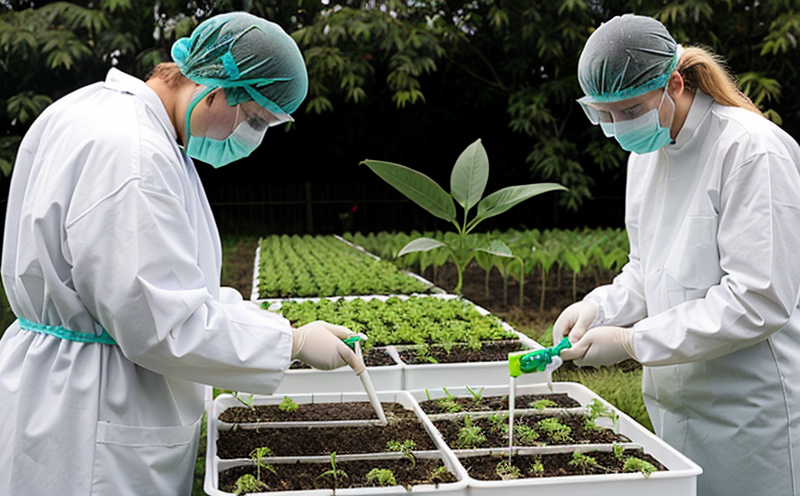Botrytis Cinerea (Gray Mold) Testing
The detection and quantification of Botrytis cinerea in agricultural products is crucial for maintaining quality standards and ensuring compliance with international trade regulations. This pathogen, commonly known as gray mold, causes significant economic losses by infecting fruits, vegetables, flowers, and ornamental plants. Accurate testing helps farmers, processors, and retailers to identify infected products early, preventing further spread of the disease and minimizing financial impacts.
The first step in Botrytis cinerea testing involves collecting samples from suspected areas where fungal growth is observed. Samples can be taken directly from affected tissues or by using air sampling methods for detecting spores in the environment. Once collected, these samples undergo preliminary examination to ensure they are suitable for further analysis.
In laboratory settings, testing typically employs molecular techniques such as quantitative PCR (qPCR), which allows for precise quantification of pathogen DNA within a given sample. Alternatively, traditional culture methods may still be used, though they lack the sensitivity and speed offered by modern molecular diagnostics. Immunological assays like enzyme-linked immunosorbent assays (ELISAs) provide another means to detect specific antibodies against B. cinerea.
For accurate results, it is essential that proper sample preparation precedes any form of analysis. This includes thorough homogenization followed by filtration or centrifugation steps aimed at removing debris and other non-target materials from the solution containing potential pathogens. It’s also important to note that cross-contamination must be avoided during all stages of sample handling.
Once prepared, samples are subjected to various types of instrumentation depending on which analytical approach is being utilized—whether it's high-throughput sequencing for identifying diverse microorganisms present or specialized equipment designed specifically for detecting fungal pathogens through fluorescence detection channels. Reporting protocols vary based on the chosen method but generally include detailed descriptions of detected levels of B. cinerea alongside recommended actions if necessary.
The importance of Botrytis cinerea testing cannot be overstated given its wide-ranging effects across different agricultural sectors. By implementing robust quality assurance measures early in the supply chain, stakeholders can reduce risks associated with contaminated produce while enhancing overall product safety standards.
Frequently Asked Questions
Quality and Reliability Assurance
The reliability of Botrytis cinerea testing relies heavily on standardized procedures outlined in international standards such as ISO 14695:2013 which provides guidelines for microbiological examination methods. Adherence to these protocols ensures consistent results across laboratories worldwide.
- Standard Operating Procedures (SOPs): These documents outline step-by-step instructions for each phase of the testing process, from sample collection through final reporting.
- Calibration and Maintenance: Regular calibration of instruments used in testing is crucial to ensure accuracy. Additionally, regular maintenance checks help prevent equipment failure during critical stages of analysis.
A robust quality management system (QMS) plays a vital role in maintaining high standards throughout the entire testing lifecycle. This includes continuous training for personnel involved in sample preparation and interpretation of results, ensuring they stay updated with latest developments in this field.
Competitive Advantage and Market Impact
Accurate Botrytis cinerea testing contributes significantly to a company's competitive edge by enabling them to maintain consistent product quality and meet stringent regulatory requirements. In today’s globalized market, where consumers demand transparency about the origin and safety of their food products, reliable testing services become indispensable tools for businesses seeking long-term success.
By implementing rigorous quality assurance practices, companies can demonstrate their commitment to sustainability and ethical farming practices, thereby enhancing brand reputation among eco-conscious consumer groups. Moreover, early detection allows firms to implement corrective measures promptly, reducing potential financial losses associated with contaminated shipments or recalls.
Use Cases and Application Examples
Supply Chain Monitoring: Continuous monitoring at different points along the supply chain helps identify potential issues before they escalate into major problems. For instance, regular testing of incoming raw materials ensures only uncontaminated items proceed further downstream.
Research & Development (R&D): Understanding how pathogens like Botrytis cinerea interact with specific crop varieties aids researchers in developing resistant strains or improved cultivation techniques.
In conclusion, Botrytis cinerea testing is an integral part of maintaining agricultural productivity and ensuring food safety. Through meticulous adherence to best practices and cutting-edge technologies, laboratories can provide reliable results that contribute positively towards both industry sustainability goals and consumer health concerns.





